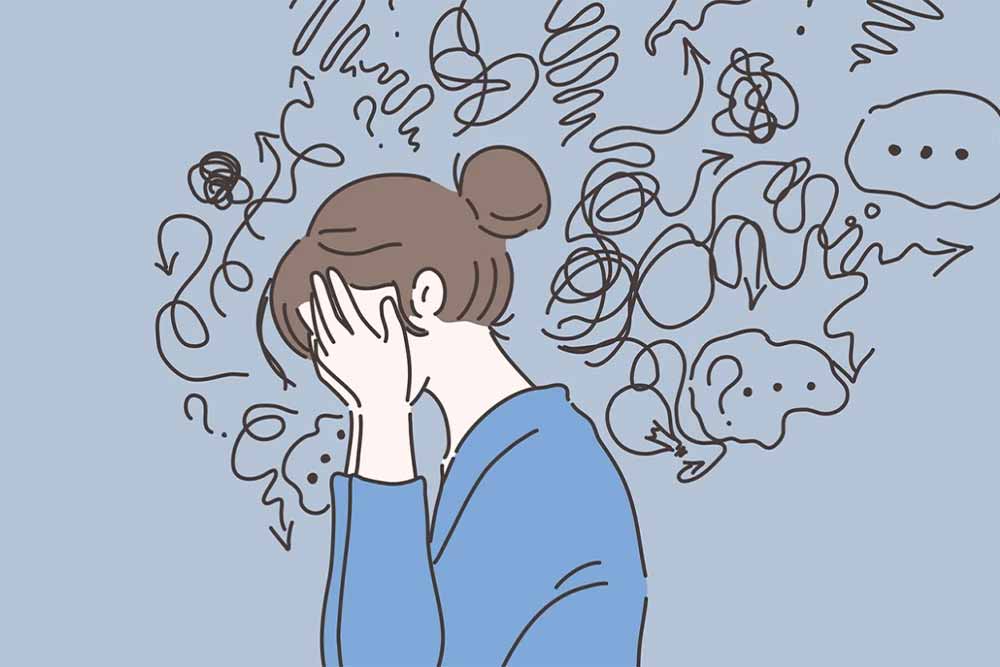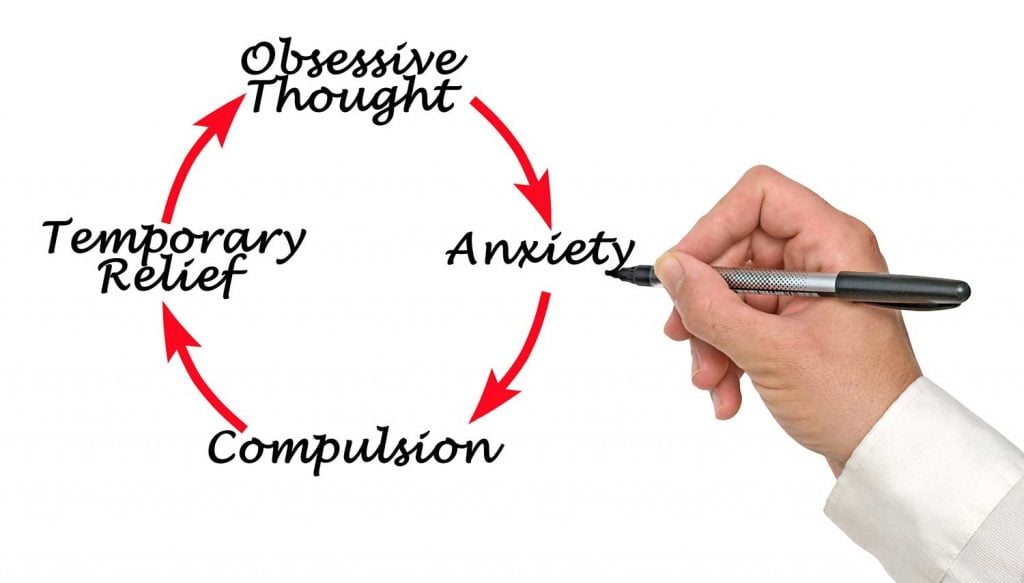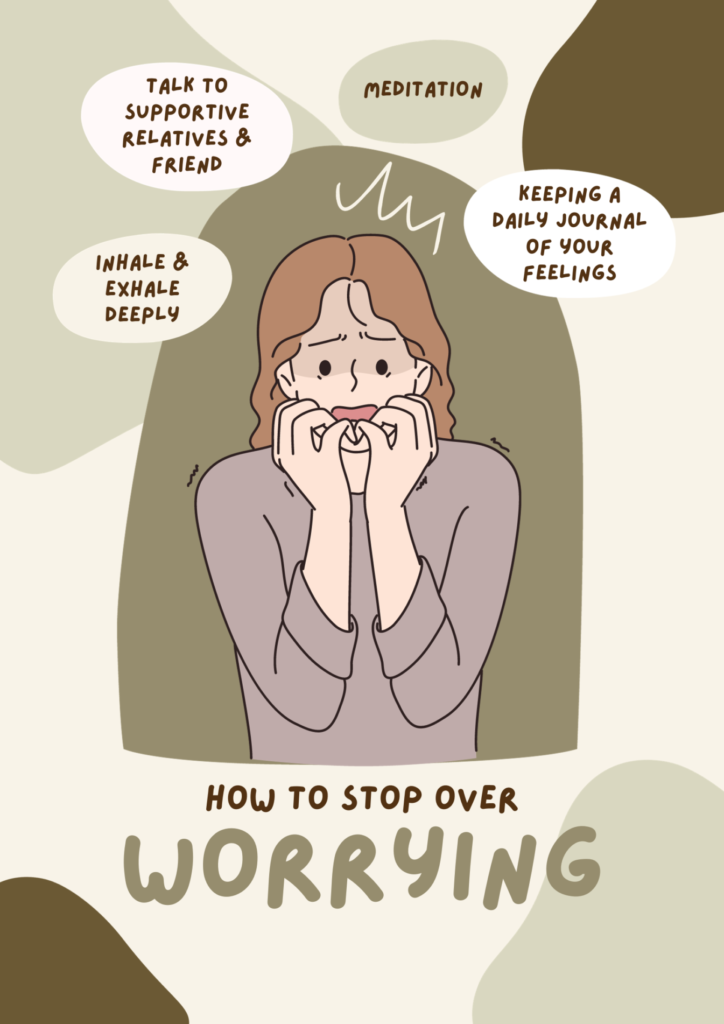Intrusive thoughts are unwanted thoughts and images that pop into your head spontaneously, resulting in impulses, sensations, or urges, which often cause distress or anxiety.
These thoughts are commonly associated with unpleasant themes such as harm or causing accidents, sexual behaviors, making mistakes, anxiety about relationships, or fear of contamination.
Such themes generally provoke emotional distress, especially when perceived as being out of character or against the person’s values.

Intrusive thoughts are often at the root of the OCD experience. Having intrusive thoughts does not mean you have OCD, but if you find yourself trying to suppress these unwanted thoughts and fears with compulsions (behaviors or rituals used to try and prevent a dreaded situation from happening), this can be a sign of OCD.
“It is like my ritual talks to me, like my ritual says this or that to me. Sometimes I don’t know if it’s a voice or a feeling. I don’t know. My voice talks to me. Occasionally they are all shouting in my head, “You’ve got to do it, you’ve got to do it, you have to.”
Live Experience of OCD Compulsions (Christy)
How to know if you have OCD-related intrusive thoughts?
To better understand intrusive thoughts, it is important to recognize that they are a normal part of the human experience and do not necessarily reflect a person’s true desires or intentions.
Intrusive thoughts on their own aren’t a mental health issue. The primary difference between intrusive thoughts that occur in the presence of anxiety and those that do not is how these thoughts are classified.
Those with diagnosed clinical OCD are more likely to judge their thoughts as bad, immoral, and dangerous and are more likely to feel guilt or shame surrounding these thoughts. Thinking ‘this is a bad thought’ creates urges to try to fix it immediately.
They are also more likely to try to restrain these thoughts and prevent the feared potential consequences from occurring. This thought process tends to intensify the strength of the intrusive thought and can lead to more serious implications.
Anxiety with OCD makes you put the rest of your life on hold. You can’t stop thinking about it. Like, if there is something on your mind, you can’t let it go. You can stop for awhile, but you always have to go back. It would be nice to just walk away, but you can’t. It is like, just straighten it and get it over with. It is like you give in and don’t try to go against it. The one little voice says, “Go ahead. Just do it. Get it over with,” or I’ve got to do it.” The other little voice says, “Fight it. Don’t give in.” I have a battle in my head. And then once I do it, I can’t stop. Even though I don’t want to do it, I have to do it.
Lived Experience of OCD Intrusive Thoughts (Grace)
What characterizes an intrusive thought as a component of OCD is how much emotional distress these thoughts cause and whether or not you try to neutralize these thoughts through compulsions.
For someone with OCD, it can feel impossible to let these thoughts go, no matter how irrational they seem. This is what leads someone to engage in compulsions to alleviate intrusive thoughts.
People without clinical anxiety or OCD, on the other hand, are more likely to dismiss their thoughts as out-of-character and go on about their day. They do not let the thoughts impede their daily life, and they tend not to ruminate on the deeper meanings of the thoughts.
Common Obsessions of Intrusive Thoughts OCD
There are several different types of intrusive thoughts. Some common themes include:
- Violent or aggressive acts, specifically causing harm against yourself or other people
- Fear of germs, infections, or contamination
- Self-doubts about doing tasks wrong or leaving tasks unfinished
- Fear or committing a sin, blasphemous behavior, or being an immoral person
- Participating in sexual acts or behaviors
- Embarrassing yourself in public
- Fear of something terrible happening
Common Compulsion of Intrusive Thoughts OCD
Compulsions are the behaviors or actions in which a person may engage to neutralize and reduce the anxiety caused by their intrusive thinking.
Examples of common compulsions include:
- Constantly repeating a ritual or behavior
- Checking on yourself and others in order to ensure no harm has been done
- Continually thinking or ruminating about the intrusive thoughts
- Seeking reassurance or validation from others
- Having an intense need to perform a task “just right”
- Avoiding objects, places, or people that can trigger one’s intrusive thoughts
Do OCD thoughts mean anything?
People who experience intrusive thoughts tend to become worried about what they might mean. They may have a difficult time realizing their thoughts are just thoughts.
The presence (or absence) of intrusive thoughts isn’t a good marker of well-being. It’s about our attitude towards them and how we respond. Thoughts aren’t facts and don’t always require a response. We have limited control over what thoughts enter our heads. But we do have a choice about whether to act on them.
While these sensations, ideas, memories, urges, and images might be disturbing and distressing, they often have no particular meaning. If the individual has no desire or intention of acting on the thoughts, then they should not worry about any deeper meaning.
Unfortunately, it is easy for someone with OCD to attempt to fight these thoughts and protect against them, and the harder a person fights them, the stronger they get.
It is important to remember that these thoughts are not future predictions or reality-based.
For someone with OCD, intrusive thoughts can feel nearly impossible to ignore, and the mind can become completely absorbed by these obsessions. The pain and distress we experience are not intrusive thoughts but rather the amount of power we give these thoughts.
What causes intrusive thoughts?
Intrusive thoughts might not have a “cause.” They can happen randomly and pop into your head. Just as easily as they wander into your brain, they exit and leave no lasting impression.
However, with OCD, intrusive thoughts occur when an individual does not complete a particular behavior or habit (compulsion). A person with OCD will often try to suppress or stop their unwanted thoughts (obsessions) through rituals or repetitive behaviors.
This usually leads to a vicious cycle that involves repeating these particular behaviors or habits over and over to suppress the obsessions, reinforcing the obsessive thinking.

Why do OCD thoughts seem so real?
Individuals who suffer from OCD tend to have a limited tolerance of uncertainty and perfectionistic tendencies. They want to know that whatever we have intrusive thoughts about will never happen or is completely false.
However, it is impossible to know with absolute certainty that what we fear has no meaning behind it or will never happen. That is what makes these thoughts so distressing for people with OCD.
While people without OCD might have the same thoughts, images, and urges, they do not attribute any meaning to them and our brain often filters them out as unnecessary or faulty information.
They can dismiss them and move on. But unfortunately, people who do suffer from OCD become filled with fear and intense anxiety and get stuck on these thoughts and attribute meaning to them.
Treatment: Managing intrusive thoughts by stopping compulsive behaviors
Thought suppression is among the strategies people employ to manage or control thoughts that evoke unpleasant emotions.
According to the ironic process theory of mental control, anyone engaging in thought suppression is likely to experience the frequent intrusive return of that thought.
This phenomenon is termed the rebound effect, which is the increased frequency of a previously suppressed thought. This effect has been consistently observed in various studies.
In the presence of anxiety and Obsessive-Compulsive Disorders, we should not try to suppress our intrusive thoughts. Rather, these thoughts should be examined, confronted, and worked through.
We might wish never to experience an intrusive thought again, but that is impossible. Instead, the goal of treatment is to learn to accept the thoughts and let them flow through your mind as though they’re any other thought.
Exposure Response Prevention (ERP), a type of Cognitive Behavior Therapy, is the most common treatment option for OCD. ERP involves deliberately exposing oneself to intrusive thoughts, objects, and situations that make you anxious, and then preventing yourself from engaging in compulsive actions in reaction to these thoughts.
Over time, the hope is that you will become less sensitive to the things that once caused you great anxiety — including intrusive thoughts.
It is sometimes possible to use mindfulness and meditation to treat OCD. Yoga, taking walks outside, and other forms of self-care can also be beneficial ways to infuse your life with more positivity.
Strategies to Prevent Compulsions
Both of these techniques offer a different perspective from the traditional suppression approach, which can sometimes be counterproductive.
By practicing focused-distraction and acceptance, you’re equipping yourself with tools that aim to provide a more effective way to manage and cope with intrusive thoughts.
Focused-Distraction
One approach is to gently redirect your attention away from the intrusive thought.
For instance, whenever an unwanted thought comes to mind, try to immerse yourself in a pleasant memory, like a specific weekend spent with friends.
The goal isn’t to forcefully push the thought away but to give your mind a different, more positive focus. It’s a bit like changing the channel in your mind.
Over time, you might find that this helps in reducing the frequency and intensity of intrusive thoughts.
Acceptance
Another technique involves a more mindful approach.
Imagine your intrusive thought as a sign carried by a little soldier marching out of your ear. Instead of fighting or resisting the thought, simply observe it.
Watch the “soldiers” and their “signs” march by without judgment, like you’re watching a parade.
This method is about acknowledging the thought without letting it dominate your emotions or reactions. It’s a way of saying, “I see you, thought, but you don’t control me.”
Can OCD intrusive thoughts change?
Yes, both compulsions and obsessions can change with time. The underlying emotions and fears tend to remain the same, but one’s age, culture, and life experiences can affect the themes of intrusive thoughts. The compulsive behaviors used to reduce anxiety can also shift.
It is important to note, though, that the types of OCD symptoms one has tend to remain fairly consistent over time. For example, suppose someone has a fear of germs, infections, or contamination early in life. In that case, they will unlikely develop a fear of committing a sin or blasphemous behavior later in life.
While the themes of the intrusive thoughts remain the same, the OCD symptoms can shift within the same symptom type.
So, for someone with a contamination-related obsession, they might have a strong urge to wash their hands or frequently shower at a young age, but later in life, they might shower less, and instead use a very specific process or ritual for washing themselves.
Will OCD intrusive thoughts ever go away?
Unfortunately, it is impossible for anyone to completely eliminate intrusive thoughts because no matter how hard you try to push them away, they will continue to make their way back into your consciousness.
Proper treatment can help reduce the obsessions and compulsions that come with OCD. You might continue to have intrusive thoughts, but this does not mean they have to turn into an obsession.
| THINK recovery looks like | REALLY recovery looks like |
|---|---|
| Never having or being bothered by intrusive thoughts | Intrusive thoughts come, but we can learn to handle them well. |
| Linear recovery | Occasional lapses/relapse |
| Never having obsessions | Living a fulfilling life despite what OCD says |
| Finding the miracle answer | Comfortable never gaining certainty |
Are intrusive thoughts normal?
Intrusive thoughts are far more common than typically believed. While intrusive thoughts are predominantly associated with obsessive-compulsive disorder (OCD) or among the symptoms of other anxiety disorders, having an intrusive thought once in a while is a normal part of life.
Research has found that over 90% of the population experiences intrusive thoughts (Abramowitz, Deacon, & Whiteside, 2019).
While everyone has intrusive thoughts from time to time, if these thoughts are happening often, causing significant concern, or interfering with your daily life, it is important to seek professional help.
Intrusive thoughts are usually nothing to worry about, but if you feel guilt or shame about your intrusive thoughts or feel like you need to control them, you might be experiencing something more serious.
Sources
Abramowitz, J. S., Deacon, B. J., & Whiteside, S. P. (2019). Exposure therapy for anxiety: Principles and practice. Guilford Publications.
Abramowitz, J. S., Tolin, D. F., & Street, G. P. (2001). Paradoxical effects of thought suppression: A meta-analysis of controlled studies. Clinical Psychology Review, 21(5), 683-703.
Beaman, C. P., & Williams, T. I. (2010). Earworms (stuck song syndrome): Towards a natural history of intrusive thoughts. British Journal of Psychology, 101(4), 637-653.
Challacombe, F. L., Bavetta, M., & DeGiorgio, S. (2019). Intrusive thoughts in perinatal obsessive-compulsive disorder. BMJ, 367.
Eifert, G. H., & Forsyth, J. P. (2005). Acceptance and Commitment Therapy for anxiety disorders: A practitioner’s treatment guide to using mindfulness, acceptance, and values-based behavior change strategies. New Harbinger Publications.
Hayes, S. C., Strosahl, K. D., & Wilson, K. G. (1999). Acceptance and Commitment Therapy: An experiential approach to behavior change. Guilford Press.
Julien, D., O’Connor, K. P., & Aardema, F. (2007). Intrusive thoughts, obsessions, and appraisals in obsessive–compulsive disorder: A critical review. Clinical Psychology Review, 27(3), 366-383.
Najmi, S., Riemann, B. C., & Wegner, D. M. (2009). Managing unwanted intrusive thoughts in obsessive–compulsive disorder: Relative effectiveness of suppression, focused distraction, and acceptance. Behaviour research and therapy, 47(6), 494-503.
Seli, P., Risko, E. F., Purdon, C., & Smilek, D. (2017). Intrusive thoughts: Linking spontaneous mind wandering and OCD symptomatology. Psychological research, 81, 392-398.
Wegner, D. M. (1994). Ironic processes of mental control. Psychological Review, 101(1), 34-52.




